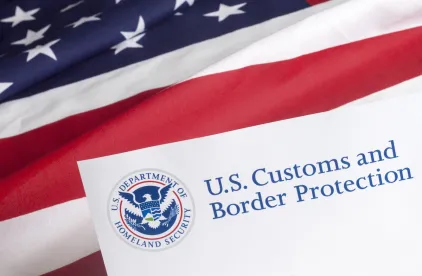To paraphrase U.S. Customs and Border Protection (CBP), the Enforce and Protect Act (EAPA) is a “game-changer.” Signed into law in 2015 by President Obama, EAPA has significantly enhanced the U.S. government’s ability to investigate and combat antidumping (AD) and countervailing (CVD) duty evasion. According to CBP, as of October 1, 2020, EAPA has led to 131 investigations, more than 30 foreign on-site visits or verifications and the identification of more than $600 million in AD/CVD duties owed to the U.S. government.
With this enforcement record as a backdrop, CBP has signaled a desire to expand EAPA authority into other compliance areas beyond the investigation of potential evasion of AD/CVD duties. Is another “game-changing” expansion of CBP authority on the horizon in 2021? Below, we review EAPA and discuss what may lie ahead.
Background
What is AD/CVD Duty Evasion?
Generally, AD/CVD duties are imposed to provide relief to domestic industries injured by unfair import competition. AD duties are imposed on imported goods sold at less than fair value, and CVD duties are imposed on imported goods subsidized by a foreign government. The Department of Commerce (DOC) determines whether dumping and subsidies are occurring, while the U.S. International Trade Commission (ITC) determines whether the U.S. domestic industry is injured because of the dumped and subsidized imports.
In turn, “evasion” in the context of EAPA is defined as:
entering covered merchandise into the customs territory of the United States by means of any document or electronically transmitted data or information, written or oral statement, or act that is material and false, or any omission that is material, and that results in any cash deposit or other security or any amount of applicable antidumping or countervailing duties being reduced or not being applied with respect to the merchandise. (19 U.S.C. § 1517(a)(5)(A))
Although evasion can take multiple forms, one of the more common forms of AC/CVD evasion in recent years is the import of Chinese-origin goods by way of a third country (i.e., transshipment). See, e.g., Notice of Determination as to Evasion, July 23, 2020 (finding that substantial evidence existed to show that a manufacturer of innersprings evaded AD/CVD orders by importing Chinese-origin innersprings through Thailand). Evasion may also result from the misclassification and undervalution of imported goods.
What Does an EAPA Proceeding Look Like?
One of the hallmark features of an EAPA proceeding is the establishment of concrete administrative deadlines for the purpose of promoting speed and efficiency. However, this process places a significant burden on the importer under investigation, especially when CBP decides to apply interim measures. Further, the investigated party is often at a disadvantage because confidential information is redacted from the administrative record and EAPA does not have a mechanism for accessing these details during the investigation. In other words, the accused evader may be unable to see (and respond to) the specific facts that support the determination of evasion.
The primary stages of an EAPA proceeding are briefly summarized below (see 19 CFR Part 165 for details):
-
Initiation: An “interested party” (e.g., U.S. manufacturer, producer or wholesaler) may submit an “e-Allegation” to CBP through an online portal when the interested party believes that a U.S. importer is evading the payment of AD/CVD duties. Upon receipt of a properly filed EAPA allegation, CBP, through its Trade Remedy Law Enforcement Directorate (TRLED), has 15 business days to determine whether to investigate. CBP will initiate an investigation if the allegation “reasonably suggests” there is evasion.
-
Interim Measures: Within 90 calendar days after initiating an investigation, CBP will implement interim measures if it determines there is a “reasonable suspicion” of evasion. Interim measures may include suspension of liquidation, collection of AD/CVD deposits, intensive examination of import shipments and “such additional measures as CBP determines necessary to protect the revenue of the United States.” Interim measures will remain in place during the course of the investigation.
-
Investigation: CBP will gather information through requests for information, site visits and voluntary submissions. This review can be quite burdensome and include requests for import documents, production records and corporate/financial information. An adverse inference may be applied to a party that fails to cooperate or comply with the investigation (to the best of its ability).
-
Final Determination: Within 300 calendar days (unless extended), CBP will decide whether an affirmative determination of evasion is supported by “substantial evidence.” If CBP makes an affirmative determination, the agency must: continue to enforce interim measures; seek a determination of the applicable AD/CVD assessment rate or cash deposit rate from DOC; and assess AD/CVD duties consistent with DOC instructions.
-
Administrative Review/Appeal: Within 30 days after CBP’s Final Determination, any party to the investigation may request a de novo administrative review, which must be completed within 60 days. Subsequently, the losing party may seek judicial review in the U.S. Court of International Trade (CIT) within 30 days of the completion of the administrative review.
Increased EAPA Enforcement Equals Increased EAPA Litigation
The upward trend in EAPA enforcement is stark. In fiscal year (FY) 2020 alone, EAPA resulted in 64 investigations and the prevention of duty evasion estimated at $287 million — a 500 percent increase since the EAPA program began in fiscal year 2017. According to CBP, the majority of its EAPA investigations in FY2020 involved Chinese goods transshipped through third countries, including Cambodia, the Dominican Republic, India, Malaysia, Laos, Taiwan, Turkey, Thailand or Vietnam. See CBP Press Release (dated October 21, 2020).
Unsurprisingly, CBP’s increased enforcement efforts have also led to increased litigation, often premised on alleged deficiencies related to the administrative process. For example, on November 4, 2020, an importer of wooden bedroom furniture from China filed a lawsuit in the CIT alleging that CBP, in conducting its EAPA proceeding, violated the Administrative Procedures Act (APA) by misapplying deadlines and relying on unsupported claims when it determined that the importer evaded AC/CVD duties (Aspects Furniture Int’l, Inc. v. United States, No. 20-03824).
In another count, the importer also asserted a constitutional challenge to EAPA, asserting that the statute impermissibly allows CBP to: (1) impose interim measures without receiving a response from the affected importer; and (2) render a final determination without giving the affected importer access to the complete and unredacted administrative record. Based on the current briefing schedule, the plaintiff in Aspects Furniture is slated to file a motion for judgment upon the agency record in April 2021.
Notably, Aspects Furniture came on the heels of a similar lawsuit that alleged, in part, that CBP failed to properly disclose information that it relied upon to support its evasion determination (Royal Brush Mfr., Inc. v. United States, No. 19-00198). On December 1, 2020, the CIT ruled in favor of Royal Brush, remanding the CBP’s evasion determination after finding that the government failed to meet its obligations under 19 CFR § 165.4, which requires CBP to provide, where possible, a public summary of any redacted or business confidential information in the EAPA record. What made this case “particularly concerning” to the court was the government’s failure to provide a public summary of redacted information in a site visit report — a report that the agency relied upon in making its final determination.
EAPA’s Future in a Biden Administration
As the Biden administration continues to take shape, CBP’s specific enforcement priorities remain uncertain. Newly confirmed Secretary of the Department of Homeland Security (DHS), Alejandro Mayorkas, has yet to provide any signals; and a nominee for commissioner of CBP has yet to be named. That said, the Biden administration has not been shy in asserting its intent to aggressively confront China using the full toolkit at its disposal. Based on CBP’s recent track record, expanded EAPA authority may be viewed as a natural element of a broader trade and trade enforcement policy in relation to China.
Moreover, if the agency’s public statements at the end of 2020 serve as any clue, it can be expected that EAPA investigations will continue to be a high priority moving forward. In its “21st Century Customs Framework” — a reform and modernization effort aimed at creating an “agile, efficient, data-driven, interconnected, and secure” customs enforcement process — CBP specifically cited EAPA as a key component. We note that this is not the first time CBP has raised the possibility of expanding EAPA authority to cover more than AD/CVD evasion. But by many accounts, the current trade climate is more favorable than ever for EAPA expansion — a prospect that should certainly be concerning for U.S. importers.
Perhaps the more glaring question is not when, but where an expansion of EAPA authority would begin. EAPA could, for example, be expanded to cover existing Priority Trade Issues (such as Trade Agreements or Textiles/Wearing Apparel — consider, for example, the recent forced labor concerns addressed in our December 17, 2020, client alert). More interesting, however, some observers believe that, given EAPA’s apparent success in collecting unpaid duties, EAPA could be expanded to cover duty evasion under Section 232 of the Trade Expansion Act of 1962 and Section 301 of the Trade Act of 1974, which typically include lost revenue due to misclassification, undervaluation, or country-of-origin determination issues.
Conclusion
Whatever the future holds, CBP’s recent trend of aggressive enforcement under EAPA serves as a warning for importers to elevate their reasonable care efforts and internal review activities to avoid unintended missteps surrounding customs compliance.





 />i
/>i
